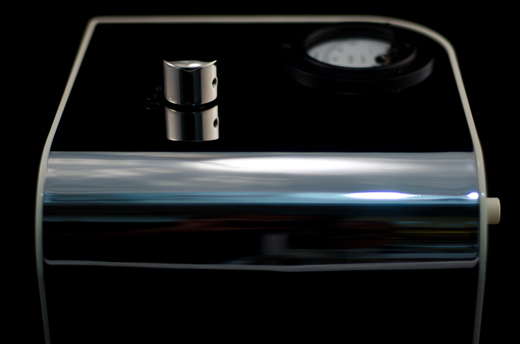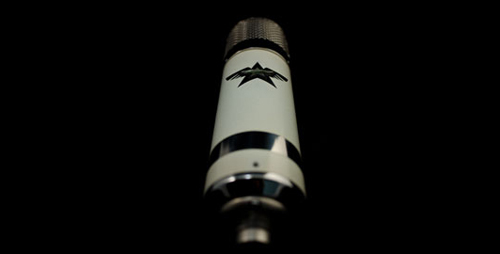Made In NY: Ronin Applied Sciences
One of the most crowded booths at the year’s AES convention was also one of its smallest.
Almost everything about these few dozen square feet, nestled deep in back rows of the trade-show floor, was memorable: From the single microphone on display, to the rigid black business cards, to the perpetual queue of onlookers, and the man in the booth himself.
Dimitri Wolfwood, the slight and sharp-eyed young designer behind Ronin Applied Sciences, speaks in complete, precise paragraphs. His manner is assertive and polite at once and he carries that half-cocky, half-conciliatory attitude of a driven professional.
When I first met Wolfwood at a Tape Op afterparty, Engineers Larry Crane and Joel Hamilton introduced me to him with broad smiles and back-clapping praise. I was told he had invented a new microphone. “Oh, neat, what’s it based on?” I asked, thinking it was only natural to ask which of the erstwhile old favorites a boutique designer was trying to re-create.
“Nothing,” said Wolfwood. “It’s not based on anything. It’s a completely new design.”
Whether you fall under the mic’s spell or not, it’s impossible to deny that there’s something uniquely novel about each stage of the first microphone from Ronin Applied Sciences. But what first caught my eye about the Pegasus large-diaphragm condenser microphone was its power supply.
First of all, it’s enormous. And secondly, its sleek, contoured design looks somewhere between a futurist toaster and a Mac Mini. This is the tube microphone as re-designed by Steve Jobs. Most intriguing however, is what this power supply allows the mic to do.
Wolfwood designed the tube in the Ronin Pegasus to run in pentode mode, as opposed to the more conventional triode.
“Most microphones essentially run their tube in starved-plate mode,” he says, indicating that the tube is under-nourished by both current and voltage.
“That can be okay if you’re trying to force some ‘warmth’ out of the microphone. But if you put that mic up in front of a belter like an Aretha Franklin, an Alicia Keys or a Steven Tyler, things start getting a little weird.”
As he gets to talking about distortion, Wolfwood begins to light up. This is one of the key points of his design, and when he describes it, he sheds his composed self-contained manner and his voice finally becomes insistent: “Essentially, I don’t want the sound of my microphone to change with level. I want it to be what it is, and present its sonic palette in the most stable, reliable, and repeatable fashion until you actually overload the microphone.”
“In which case” he says, “I’ve designed the microphone to not overload.”
The Pegasus’ design allows it to “swing one full volt” of input power before clipping. For those who aren’t familiar with the inner workings of a microphone, that’s a tremendous amount of juice.
This fully-powered pentode and its related circuitry makes for a microphone that’s remarkably low in noise as well as total harmonic distortion. And any distortion that does remains is evenly spread across the harmonic spectrum frequency, where it’s less audible. According to Wolfwood, noticeable levels of THD should barely even set in until unusually high sound-pressure levels are reached. But, he laughs, “the capsule is more likely to fold before that happens.”
The circuitry of the microphone is so powerful, in fact, that its amplifier section does more than handle impedance conversion. Given a healthy signal, it can even deliver a full-fledged, low-impedance line-level output. This means that in many cases, the microphone could even be run without a mic preamp if desired, plugging straight into a multi-track recorder.
Before sound reaches the novel circuitry of the Ronin Pegasus, it hits an equally unusual large-diaphragm capsule.
“We use an ultra-low-mass 1-micron diaphragm, mounted onto a completely redesigned K47 back-plate,” says Wolfwood. “Our diaphragm reaches down just 1db at 20kHz, and stays there all the way up until 30kHz. And naturally, it’s made here in America.”
According to Wolfwood, the remarkably low mass of the capsule increases transient response and high-frequency handling, while smoothing out the bandwidth of the Pegasus’ subtle high-frequency lift.
In cardioid pattern, engineers can expect a broad, gentle 2-3 dB boost that spans from 2kHz to 12kHz, culminating with a gentle peak of 2.5 dB between 9 and 10kHz. It’s been described as “subtly M49-ish,” but Wolfwood doesn’t like to go around comparing his mics to others’.
Each of the mic’s patterns has a completely different acoustic profile. The omni-directional setting is “almost razor flat” with a slight dip at the very top, while the bi-directional pattern has a more pronounced midrange “push”.
As painstaking as his design is, there will be those engineers who roll their eyes at Wolfwood’s efforts. For years, there has been a vocal population of musicians and recordists who bemoan many of the updates that are made to improve on the specs of great-sounding classics. An obsession with the stats, they say, can lead designers to ignore the soul and the sound of a design. At times, they’ve been right.
Wolfwood is all too familiar with those types of criticisms, and insists his is “not just a paint-by-numbers design.”
When I ask him about his background and training, Dimitri Wolfwood says he admires technicians like Stephen Paul, and more personally, Tony Merrill, who he considers a true mentor.
“These were the first guys to crack open old mics and say ‘you could use some better parts in here’. They opened up microphones and asked how to make them better. A lot of guys disagreed with that at the time. Some of them still do.” As soon as those last words are out of his mouth, he hurriedly dismisses them: “But that’s not relevant to me.”
“From the very start,” he says, “I wanted to make a clean microphone that wasn’t cold. A clean microphone that wasn’t hard or sterile or boring. I think it’s a missing part of the palette. A microphone that’s clean – but beautiful. Thus far, according to the responses I’ve gotten, I’ve achieved that goal, and I’m very proud of that.”
The Ronin Applied Sciences Pegasus is distributed in New York by Ecstatic Electric Audio, and can also be purchased direct from the manufacturer at roninappliedsciences.com. It carries a list price of $4,200 and is available in a tightly limited run of 100 units.
Justin Colletti is a Brooklyn-based producer/engineer who works with uncommon artists, and a journalist who writes about music and how we make it. Visit him at http://www.justincolletti.com.
Please note: When you buy products through links on this page, we may earn an affiliate commission.










Bob Ebeling
March 18, 2012 at 2:06 am (13 years ago)I just testdrove this mic and it is truly incredible. He is not just talking smack, this kid is a new guru. The mic and the designer are destined for greatness.